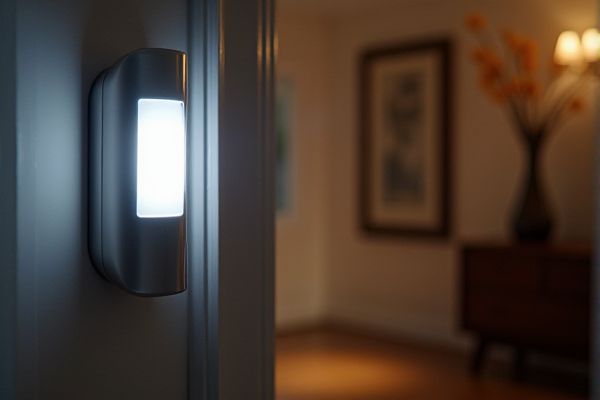
Motion sensor lights activate automatically when they detect movement, making them ideal for hands-free operation and energy savings. Touch lights require manual activation with a simple touch, offering direct control and easy installation; explore this article to determine which lighting option best suits your needs.
Table of Comparison
| Feature | Motion Sensor Lights | Touch Lights |
|---|---|---|
| Activation Method | Detects motion to turn on/off automatically | Activated by physical touch |
| Energy Efficiency | High - only on when motion is detected | Moderate - stays on until touched again |
| Common Uses | Security, outdoor lighting, hands-free areas | Desk lamps, bedside lights, portable lighting |
| Installation | Requires sensor installation and wiring | Simple plug-and-play or battery-operated |
| Cost | Moderate to high depending on features | Low to moderate |
| Control | Automatic; no manual switch needed | Manual control via touch |
| Response Time | Instant activation on motion detection | Immediate on touch |
| Suitability | Best for security and convenience | Best for simple on/off lighting needs |
Introduction to Motion Sensor and Touch Lights
Motion sensor lights activate automatically by detecting movement, offering hands-free convenience and enhanced security for indoor and outdoor spaces. Touch lights operate through direct physical contact, allowing users to easily turn lights on or off with a simple tap, making them ideal for desk lamps and bedside lighting. Both lighting types provide practical solutions for energy efficiency and user-friendly control in various settings.
How Motion Sensor Lights Work
Motion sensor lights operate by detecting infrared radiation emitted by warm objects, such as humans or animals, within their sensor range. They use passive infrared (PIR) sensors to identify changes in heat patterns and trigger the light to turn on automatically. These lights enhance security and energy efficiency by illuminating areas only when motion is detected, unlike touch lights that require physical contact to activate.
How Touch Lights Operate
Touch lights operate using capacitive touch technology, detecting changes in the electrical field when a user's finger comes into contact with the light's surface. This technology allows instant activation and dimming functions through simple taps or presses, offering precise control without physical switches. Unlike motion sensor lights that rely on movement detection, touch lights require direct human interaction to function.
Energy Efficiency Comparison
Motion sensor lights significantly outperform touch lights in energy efficiency by activating only when movement is detected, which reduces unnecessary power consumption. Touch lights remain on until manually switched off, often leading to longer operational periods and higher energy use. Energy-saving technologies in motion sensor lights, such as LED bulbs combined with automatic shut-off timers, further enhance their sustainability benefits.
Installation and Setup Differences
Motion sensor lights require more complex installation involving wiring, mounting sensors strategically for optimal detection, and sometimes integrating with a home automation system. Touch lights offer simple setup with no wiring needed; they usually operate on batteries or plug directly into an outlet, making them ideal for quick, portable use. While motion sensor lights provide hands-free operation benefits, touch lights excel in ease of installation and immediate usability.
User Convenience and Accessibility
Motion sensor lights offer hands-free operation by automatically illuminating spaces when motion is detected, enhancing convenience for users in dark or busy environments. Touch lights provide straightforward control through a simple tap, making them highly accessible for individuals with limited mobility or dexterity. Both lighting options improve user experience by catering to different accessibility needs and preferences.
Safety and Security Benefits
Motion sensor lights enhance safety by automatically illuminating dark areas when movement is detected, deterring potential intruders and reducing the risk of accidents caused by poor visibility. Touch lights provide quick, manual control for immediate lighting needs, ensuring safe navigation in low-light conditions without fumbling for switches. Both lighting types improve security by increasing visibility and offering convenient access to illumination in critical moments.
Durability and Maintenance
Motion sensor lights typically offer greater durability due to their sealed designs that protect internal components from dust and moisture, resulting in lower maintenance requirements over time. Touch lights, while convenient and easy to operate, often have more exposed electronic components that may require more frequent cleaning and occasional sensor recalibration to maintain optimal performance. You can reduce maintenance costs by choosing motion sensor lights, especially in high-use or outdoor environments where durability is critical.
Cost Analysis: Initial and Long-Term
Motion sensor lights typically have a higher initial cost compared to touch lights due to advanced technology and installation requirements. However, their energy efficiency and automated operation can lead to significant long-term savings on electricity bills. Your choice between the two should consider both upfront investment and the potential for reduced energy consumption over time.
Choosing the Right Option for Your Space
Motion sensor lights offer energy-efficient, hands-free operation ideal for areas needing automatic illumination, such as hallways or outdoor spaces. Touch lights provide convenient manual control and are suitable for bedside tables or cabinets where quick, localized lighting is preferred. Evaluating your space's usage patterns and accessibility will help you choose between the responsive activation of motion sensors or the tactile ease of touch lights for optimal comfort and functionality.
 homyna.com
homyna.com